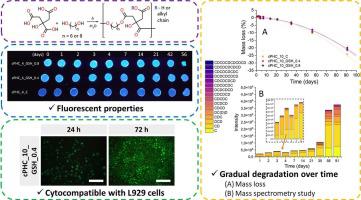Reactive & Functional Polymers ( IF 4.5 ) Pub Date : 2024-01-11 , DOI: 10.1016/j.reactfunctpolym.2024.105834 Agata Flis , Konrad Kwiecień , Izabela Misiołek , Filip Koper , Tomasz Świergosz , Wiktor Kasprzyk , Elżbieta Pamuła

|
Materials currently used for vascular grafts are characterized by limited biocompatibility. Especially challenging is obtaining the degradable graft to regenerate a patient's native tissue. Poly(alkylene citrates) (PACs) are promising for soft tissue engineering applications; however, their degradation must follow a specific profile and must not result in the formation of any substances cytotoxic to the human body. The aim of this study was to evaluate the processes that occur throughout the hydrolytic degradation of PACs with a 2:3 M ratio of citric acid and diol, additionally modified with an antioxidant compound: glutathione (GSH). The samples were tested after various time intervals of incubation in an aqueous environment (up to 3 months), taking into account the influence of the type of diol used (1,6-hexanediol or 1,8-octanediol), the time of polymer cross-linking (4 or 10 days) and the presence of a different amount of GSH (0.4 or 0.8 wt%). Structural changes in the samples were monitored by means of swelling capacity, mass changes, hardness tests, mass spectrometry, and UV spectrofluorimetry. After 3 months of degradation, a higher weight loss was observed for the samples based on 1,6-hexanediol (>20 wt%) than those based on 1,8-octanediol (6–16 wt%). Based on the values obtained, the approximate time of 80% of the mass loss was calculated, which was higher for samples cross-linked for 10 days than 4 days. The samples based on 1,8-octanediol degraded slower than those of 1,6-hexanediol, but their degradation pattern was more linear and the amount of heavy ions present in the supernatant was negligible. In vitro studies on L929 fibroblasts did not show a cytotoxic effect of the materials tested. The study proved that GSH does not cause significant changes in the degradation profiles, sufficiently providing the fluorescence properties of the materials. Furthermore, any drastic changes in the material for up to 3 weeks followed by progressive degradation may support the tissue before the regeneration process begins.
中文翻译:

谷胱甘肽改性聚(柠檬酸亚烷基酯)基聚酯的水解降解和体外研究
目前用于血管移植物的材料的特点是生物相容性有限。尤其具有挑战性的是获得可降解的移植物来再生患者的天然组织。聚(柠檬酸亚烷基酯)(PAC)在软组织工程应用中具有广阔的前景;然而,它们的降解必须遵循特定的规律,并且不得导致形成任何对人体具有细胞毒性的物质。本研究的目的是评估 PAC 水解降解过程中发生的过程,其中柠檬酸和二醇的比例为 2:3 M,另外还用抗氧化剂化合物:谷胱甘肽 (GSH) 进行了修饰。考虑到所用二醇类型(1,6-己二醇或1,8-辛二醇)、聚合物时间的影响,在水性环境中孵育不同时间间隔(最多3个月)后对样品进行测试。交联(4 或 10 天)和不同量的 GSH(0.4 或 0.8 wt%)的存在。通过溶胀能力、质量变化、硬度测试、质谱法和紫外分光荧光测定法监测样品的结构变化。降解 3 个月后,观察到基于 1,6-己二醇 (>20 wt%) 的样品比基于 1,8-辛二醇 (6–16 wt%) 的样品有更高的重量损失。根据获得的值,计算出质量损失 80% 的大致时间,交联 10 天的样品比交联 4 天的样品要长。基于 1,8-辛二醇的样品比 1,6-己二醇的样品降解慢,但它们的降解模式更加线性,并且上清液中存在的重离子量可以忽略不计。对 L929 成纤维细胞的体外研究并未显示所测试材料的细胞毒性作用。研究证明,GSH 不会引起降解曲线的显着变化,足以提供材料的荧光特性。此外,在长达 3 周的时间里,材料发生任何剧烈变化,随后逐渐降解,都可能在再生过程开始之前支撑组织。











































 京公网安备 11010802027423号
京公网安备 11010802027423号